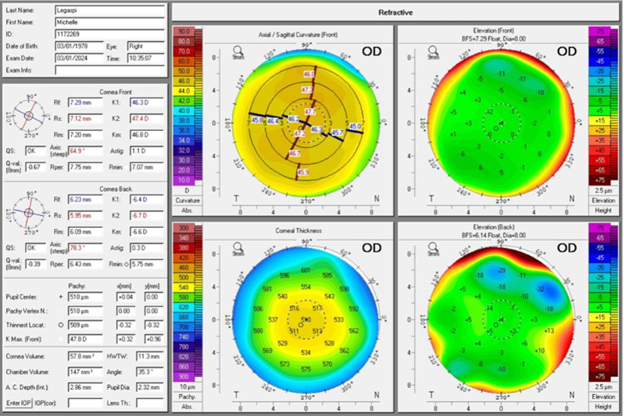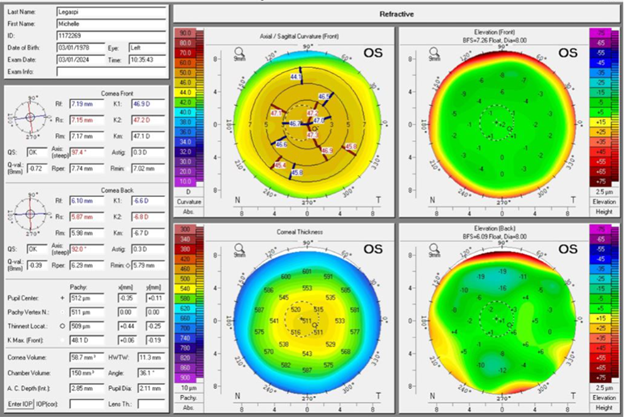OCULAR SURFACE DISEASE: Therapeutic Case
Julie Song OD, FAAO, FSLS
History
- A 46-year-old female with high myopia is a habitual soft contact lens wearer who presented for a multifocal soft contact lens fitting.
- The patient complained of recurrent discomfort with soft lens wear and that her eyes became red and uncomfortable. The patient denied contact lens misuse, but reported she does wear her lenses for long hours.
- Patient also complained of photophobia and feeling like there was sand in her eyes.
Examination
- Entering Visual Acuities: OD 20/25-1, OS 20/30
- Manifest Refraction: OD -9.25D; OS -10.25D near ADD +1.25D, BCVA 20/20 OD/OS/OU
- Slit Lamp Examination:
| OD | OS | |
| Lids/Lashes/Conjunctiva/Sclera | Meibomian gland plugging, 2+ diffuse injection on bulbar and palpebral conjunctiva | Meibomian gland plugging, 2+ diffuse injection on bulbar and palpebral conjunctiva |
| Cornea | Whorl pattern of NaFl along limbus, trace microcystic edema along limbus 360, 1-1.5 mm neovascularization 360, 1+ diffuse superior punctate epithelial erosions | Whorl pattern of NaFl along limbus, trace microcystic edema along limbus 360, 1-1.5 mm neovascularization 360, 1+ diffuse superior punctate keratitis, patch of 2.5 mm neovascularization at 7:00 |
| Anterior Chamber | Deep and Quiet | Deep and Quiet |
| Iris | Clear | Clear |
| Lens | Clear | Clear |
- Corneal Tomography Scans (Figure 1):


- Dilated Fundus Examination: Myopic degeneration in far periphery, but otherwise unremarkable.
Decision-Making Process
- Based on slit lamp examination findings and the patient’s symptoms, this patient was diagnosed with limbal stem cell deficiency.
- As the patient has high myopia and struggles with spectacle wear, we discussed this and decided to transition the patient from a daily soft lens modality to scleral lens wear as soft contact lenses are contraindicated in limbal stem cell deficiency.
Fitting and Evaluation
- Initial Diagnostic Trial Lens
- OD: Power: -3.00D; Overall Diameter (OAD): 14.9mm; Base Curve Radius (BCR): 7.50mm; standard edge lift; Center Thickness (CT): .22mm
- Centered
- No movement
- Central: 1:1/2 vault
- Paracentral: 1:1/2 vault
- Midperipheral: 1:1/2 vault
- Limbal: 1:1/4 vault
- Edges: alignment
- OS: Power: -3.50D; Overall Diameter (OAD): 14.9mm; Base Curve Radius (BCR): 7.40mm; standard edge lift; Center Thickness (CT): .22mm
- Centered
- No movement
- Central: 1:2 vault
- Paracentral: 1:1.5 vault
- Midperipheral: 1:1 vault
- Limbal: 1:3/4 vault
- Edges: alignment
- With over-refraction, the BCVA was 20/20-1 OD/OS/OU
- OD: Power: -3.00D; Overall Diameter (OAD): 14.9mm; Base Curve Radius (BCR): 7.50mm; standard edge lift; Center Thickness (CT): .22mm
- First Trial Order
- OD: Power: -6.00D; Material: Optimum Infinite; OAD: 14.9; BCR: 7.80mm; standard edge; CT: .22mm
- Centered
- No movement
- Central: 1:1 vault
- Paracentral: 1:1 vault
- Midperipheral: 1:3/4 vault
- Limbal: 1:1/4 vault
- Edges: alignment
- OS: Power: -6.62D; Material: Optimum Infinite; OAD: 14.9; BCR: 7.70mm; standard edge; CT: .22mm
- Centered
- No movement
- Central: 1:1 vault
- Paracentral: 1:1 vault
- Midperipheral: 1:3/4 vault
- Limbal: 1:1/4 vault
- Edges: alignment
- OD: Power: -6.00D; Material: Optimum Infinite; OAD: 14.9; BCR: 7.80mm; standard edge; CT: .22mm
Clinical Pearls
- Pay attention to what you recommend as a scleral lens filling solution. For patients with ocular surface disease, they should be using any of the four US Food and Drug Administration (FDA)-approved scleral lens filling solutions.
- For all scleral lens patients, but especially for scleral lens patients with ocular surface disease, it is imperative to closely measure and observe for stressors at the limbus. It is crucial to achieve an adequate balance and not overvault at the limbus or induce limbal bearing. If there is access to an anterior segment OCT available, utilize that to measure limbal clearance.
Beneficial Resources
- Craig JP, Nelson JD, Azar DT, et al. TFOS DEWS II Report Executive Summary. The Ocular Surface 2017;1-11.
- https://www.ncbi.nlm.nih.gov/pmc/articles/PMC6181806/
- https://www.sciencedirect.com/science/article/pii/S2162098923001597
